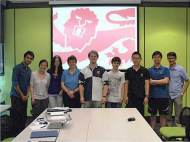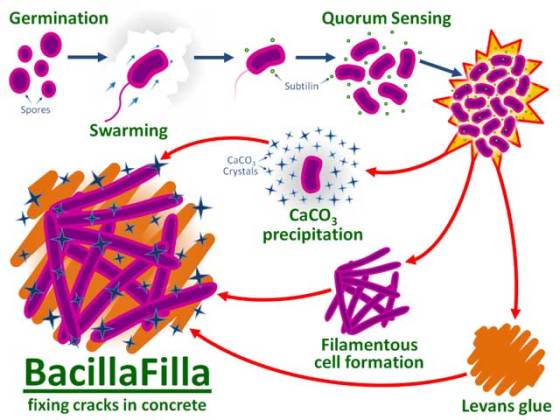BacillaFilla bacteria can repair cracks in concrete
 A bacteria that can knit together cracks in concrete structures by producing a special ‘glue’ has been developed by a team of students at Newcastle University. The genetically-modified microbe has been programmed to swim down fine cracks in the concrete. Once at the bottom, BacillaFilla produces a mixture of calcium carbonate and a bacterial glue which combine with the filamentous bacterial cells to ‘knit’ the building back together.
A bacteria that can knit together cracks in concrete structures by producing a special ‘glue’ has been developed by a team of students at Newcastle University. The genetically-modified microbe has been programmed to swim down fine cracks in the concrete. Once at the bottom, BacillaFilla produces a mixture of calcium carbonate and a bacterial glue which combine with the filamentous bacterial cells to ‘knit’ the building back together.
The nine students, whose backgrounds range from computer science, civil engineering and bioinformatics to microbiology and biochemistry, took part in the International Genetically Engineered Machines contest (iGEM), is run out of the Massachusetts Institute of Technology (MIT) in Cambridge, Boston. Over 130 teams took part in this year’s event and it is now the third time Newcastle University has won Gold.
“Around five percent of all man-made carbon dioxide emissions are from the production of concrete, making it a significant contributor to global warming. Finding a way of prolonging the lifespan of existing structures means we could reduce this environmental impact and work towards a more sustainable solution. This could be particularly useful in earthquake zones where hundreds of buildings have to be flattened because there is currently no easy way of repairing the cracks and making them structurally sound”, said joint project instructor Dr Jennifer Hallinan.
As part of the research, the students have not only considered the advantages of their engineered bacteria, but also the potential risks to the environment. The BacillaFilla spores only start germinating when they make contact with concrete (triggered by the very specific pH of the material) and they have an in-built self-destruct gene which means they would be unable to survive in the environment. Once the cells have germinated, they swarm down the fine cracks in the concrete and are able to sense when they reach the bottom because of the clumping of the bacteria.
This clumping activates concrete repair, with the cells differentiating into three types: cells which produce calcium carbonate crystals, cells which become filamentous acting as reinforcing fibers and cells which produce a Levans glue which acts as a binding agent and fills the gap.
The aim is to get together a team of students from a variety of backgrounds to design and genetically engineer a bacterium to do something novel and useful. Ultimately hardening to the same strength as the surrounding concrete, the BacillaFilla has been developed to prolong the life of structures which are environmentally costly to build.










I’m glad I found your article. The information is smart and interesting. I am unable to thank you enough for the blog posts on your web page. I know you add a lot of time and energy into them and truly hope you know how deeply I enjoy it. The written ideas you shared have expanded my knowledge and inspired me to learn more about this subject.